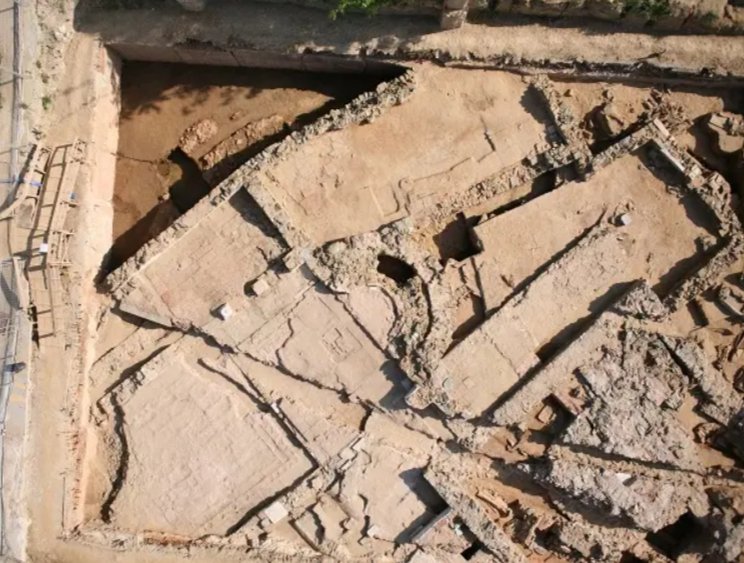In 2008, an intriguing discovery was made in a coal mine in Donetsk, Ukraine. Due to the fragile nature of the sandstone surrounding it, a mysterious object resembling an ancient wheel could not be safely removed and remains in place within the mine. This account is taken from J.P. Robinson's The Myth of Man.
While drilling the J3 'Sukhodolsky' coal coking stratum at a depth of 900 meters (about 2953 feet), workers were astonished to find what seemed to be a wheel-like imprint in the sandstone ceiling of the tunnel they had just excavated.
Deputy Chief V.V. Kruzhilin captured photos of the strange imprint and shared them with mine foreman S. Kasatkin, who helped bring the discovery to public attention. Although the site could not be closely examined, the photos and the testimony of the Ukrainian miners serve as the only evidence of this enigmatic find, which included more than one imprint.
Discovering the Wheel
Without the ability to precisely date the layer of rock where the fossilized wheel imprint was found, it has been observed that the Rostov region around Donetsk sits on Carboniferous rock, estimated to be between 360 and 300 million years old. The widely distributed coking coals in the area originated from the middle to late Carboniferous period, implying the imprint could be around 300 million years old. This suggests that a wheel may have become embedded millions of years ago and eventually dissolved through a process called diagenesis, where sediments harden into sedimentary rock, much like fossil remains typically do.
The following is an excerpt from a letter by S. Kasatkin (translated from Ukrainian), providing his account as a witness to the unusual wheel imprint discovered by his mining team in 2008:
‘This finding is not a PR action. In due time (2008), we as a team of engineers and workers asked the mine director to invite scientists for detailed examination of the object, but the director, following the instructions of the then owner of the mine, prohibited such talks and instead only ordered to accelerate work on passing through this section of lava and on fast ‘charging’ of the section with mining equipment.
Owing to that, this artifact and the smaller one found during further work came to be in a tunnel blockage and could not be taken out and studied. It is good that there were people, who in spite of the director’s prohibition, photographed this artifact.
I have connections with the people who first discovered these imprints and also with those who photographed them. We have more than a dozen witnesses. As you understand, the admission in the mine is strictly limited (it is dangerous on sudden emissions) and to obtain such permit is rather difficult.
The ‘wheel’ was printed on sandstone of the roof. Guys (drifters) tried to ‘cut away’ the find with pick hammers and to take it out to the surface, but sandstone was so strong (firm) that, having been afraid to damage a print, they have left it in place. At present the mine is closed (officially since 2009) and access to the ‘object’ is impossible - the equipment is dismantled and the given layers are already flooded.’
With only the written testimony of S. Kasatkin and his fellow witnesses, the photographs serve as the sole evidence of this unusual imprint. Despite challenges in verifying the details beyond what has been presented, the anomaly warrants attention. If the photographic evidence is authentic, it raises the question of how a man-made wheel could become embedded in ancient strata—long before humans, according to conventional scientific understanding, had even evolved.
Ancient Tracks
Evidence of wheeled vehicles in antiquity has surfaced elsewhere in the world. Petrified ancient tracks have been found in France, Spain, Italy, Malta, Kazakhstan, Ukraine, and even North America. One such prehistoric site is Misrah Ghar il-Kbir—meaning "Great Cave" in Maltese—commonly referred to as Clapham Junction. Located near the Dingli Cliffs in Siggiewi, Malta, this site is renowned for its mysterious "cart ruts" carved into the limestone, which have puzzled all who visit.
Similarly, strange tracks in stone can be seen in Sicily at the Great Theater of Syracuse, a Greek amphitheater. Many archaeologists believe the Maltese tracks were likely made by Sicilian settlers around 2000 BC, during the early Bronze Age.
Additional tracks are found in Turkey, including Sofca, where they cover an area approximately 45 by 10 miles (72 by 16 km), and Cappadocia, home to several clusters of tracks. The discovery of these ruts around the world has sparked debate regarding their purpose, age, and origins. In Malta, especially due to the proximity of the tracks to megalithic structures and the fact that some are now submerged beneath the sea, many researchers suggest these fossilized lines indicate significant antiquity.
Interestingly, in light of the anomalous wheel imprint found in Ukraine, the medieval city-fortress of Chufut-Kale, located in the Crimean Mountains, also contains stone cart ruts similar to those found at the nearby site of Eski-Kermen. Despite the ruins of Chufut-Kale, these mysterious tracks remain visible, drawing attention for their resemblance to other ancient ruts across the world.
Dr. Alexander Koltypin, a geologist and the director of the Natural Science Research Center at Moscow’s International Independent University of Ecology and Politology, has devoted significant time to studying these sites. He has examined and compared them, seeking similarities and patterns that might help explain the origins and purpose of these unusual formations.
“I first saw tracks in stone - fossilized car or terrain vehicle traces (usually called cart ruts) on Neogen plantation surface (peneplene in Phrygian) plain in May 2014 (Central Anatolia Turkey). They were situated in the field of development of Middle and Late Miocene tuffs and tuffites and according to age analysis of nearby volcanic rocks, had middle Miocene age of 12-14 million years,” wrote Koltypin.
The region that Dr. Koltypin has studied is relatively obscure, with guidebooks offering little to no information about it. While mainstream researchers argue that the tracks are merely petrified remnants of old cart ruts left by wheeled vehicles pulled by donkeys or camels, Koltypin holds a different perspective. Rejecting these conventional explanations, he stated firmly, “I will never accept it. I will always remember... many other inhabitants of our planet wiped from our history.” His research suggests a deeper, perhaps forgotten, history of Earth and its past civilizations.
After measuring the width and length of the tracks at the Phrygian Valley site, Dr. Koltypin concluded that they were made by vehicles comparable in length to modern cars, but with tires around 9 inches (22.86 cm) wide. The depth of the impressions in stone, far greater than what one would expect from small carts, led him to believe that the vehicles responsible were much heavier.
Koltypin theorizes that the civilization responsible for driving these heavy vehicles likely built the numerous identical roads, ruts, and underground complexes scattered across the Mediterranean region more than 12 million years ago. He acknowledges that petrification can occur relatively quickly, but points to the heavy mineral deposits on the tracks and signs of erosion as evidence of a much older timeline. He also connects these tracks to surrounding underground cities, irrigation systems, and wells, which he believes are millions of years old.
On his website, Koltypin wrote, "We are dealing with extremely tough lithified (petrified) sediments, covered with a thick layer of weathering, that takes millions of years to develop, full of multiple cracks with newly developed minerals in them, which could only emerge in periods of high tectonic activity."
Clearly, further research is needed to determine the true age and origins of these tracks, which have been discovered at various locations around the world. While it may be easy to attribute them to old carts, Koltypin's findings suggest that the explanation may be far more complex—possibly pointing to a lost ancient civilization with advanced technology.
The presence of the fossilized wheel in Ukraine strengthens the possibility that ancient peoples may have had access to technology and knowledge far beyond what is currently accepted.
















































